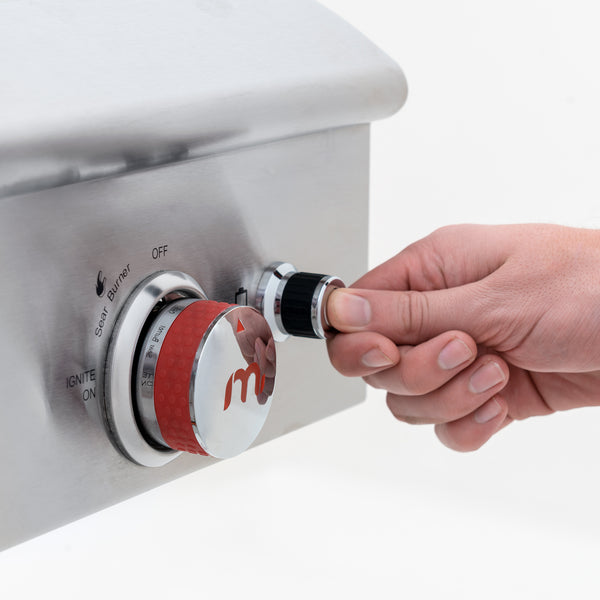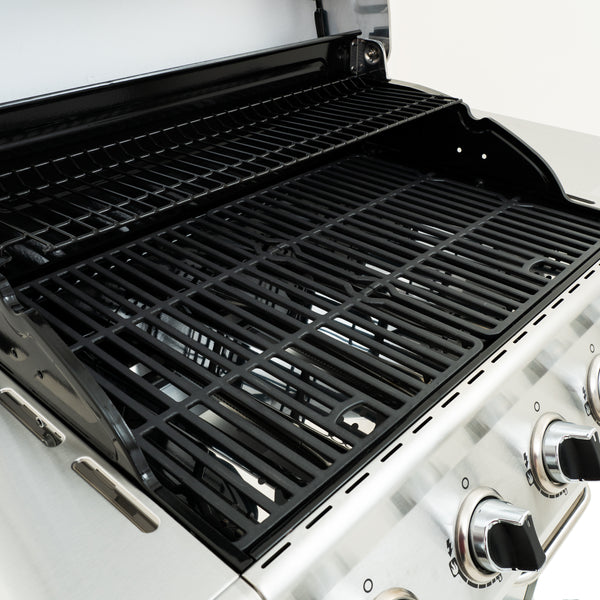Gas Grill Getting Too Hot Too Fast: Why is Your Grill Getting Scorching Hot So Quickly?
Your gas grill is designed to heat up fairly quickly.
Its ignitor lights the desired number of burners under your precise control. The flame tamers or flavorizer bars, just above the burners, build up heat from the flames and distribute heat evenly across the grill’s entire cooking surface. Even the shape of your grill’s lid or hood builds up and retains heat fast. But, that doesn’t mean your grill’s temperature is optimal to start cooking the second you turn on your grill.
Grill Temperature: How Quickly Should Your Grill Heat Up?
Generally, it should take 10-15 minutes for the inside of your grill to reach the correct temperature for cooking foods.
A gas grill is a lot like your kitchen oven in that way. Although the heat is present as soon as you ignite it, you need to let your gas grill reach the desired temperature before you can start slapping slabs of steak on its cooking surface.
Allowing your grill to preheat will enable you to cook food quicker, more evenly, and without bits sticking to the grill. Without preheating your grill, food will take longer to cook, and there will be the risk of overcooking (and drying out) your meat and other types of food.

Cooking on a Gas Grill with Direct or Indirect Heat
When cooking steaks, chops, chicken breasts, fish fillets, vegetables, and bread, you’ll want to use the direct cooking method.
To do so, preheat your grill to at least 500 degrees Fahrenheit. Again, this should take 10-15 minutes.
Use the indirect cooking method if you’re barbecuing a whole turkey or chicken, a roast leg of lamb, brisket, or ribs. Also use the indirect method for recipes that require a glaze, marinade or any sugary sauce.
For indirect grilling, preheat your grill to 350 degrees Fahrenheit. This will also take 10-15 minutes.
Never Leave Your Grill On While Unattended
Waiting for your gas grill to reach the correct cooking temperature isn’t the most exciting thing to do. You may have lots of other prepping tasks to get done for your cookout, but you should never walk away from your grill while it is preheating.
An unattended grill is as dangerous as an accidental fire. Where there is fire, there is a safety hazard. Sparks could fly and ignite flammable materials nearby, causing injury or damage to property. So stick close to your grill whenever it’s ignited.
How To Reduce the Chance of Burning or Charring
In most cases, it’s not the grill temperature that causes food to burn or char, but exposure to flare-ups. These flare-ups occur when fat or oil drips onto a gas grill’s flame tamers or burners.
Another reason you might experience flare-ups is blockages in your grill’s burner tubes. Such blockages then cause the propane gas to flow in an irregular manner, resulting in unpredictable flare-ups.
Here are some tips for preventing flare-ups from occurring:
- Always keep your gas grill clean
- Check that burners are working correctly before you use your gas grill
- Burn off any excess grease from your grill surface before you start cooking
- Always trim excess fat off meat before grilling
- Let excess sauces, marinades or bastings drip off before placing food on the grill
- When grilling fatty foods, keep your grill lid open
- Avoid using your grill in windy areas
- Don’t overcrowd your grill’s cooking surface with food
Why You Want Foods to Cook Evenly
#1 – Flavor
Natural flavors and aromas simply aren’t as prevalent when a steak has gone straight from the refrigerator to your grill. There are subtle chemical reactions that take place when a piece of meat reaches room temperature that will enhance your dish’s flavor once cooked.
#2 – Shrinkage
That’s right. Shrinkage can affect your steak. The extreme temperature change from fridge to hot grill surface forces natural juices to escape, dehydrating your meat and affecting both its taste and texture.
#3 – Juiciness
If you want juicy, flavorful meat that’s evenly cooked , take it out of the fridge and let it come to room temperature before grilling. This will allow your cut of meat to reach the same temperature throughout. It should take about 30-60 minutes, but the wait is totally worth it.
#4 – Nutritional Value
Not only does unevenly cooked meat not taste or look as good, but it also isn’t as healthy. Meat that goes straight on the grill from the fridge will have less calcium, iron, proteins and vitamins. So, for the sake of your health, it pays to let your meat come to room temperature before grilling.
Is your gas grill getting too hot? It may be a faulty gas grill regulator. Search for replacement parts here.
How Too Much Heat Too Quickly Can Cause Uneven Heating
When your grill temperature is too hot, your meat will start to burn on the outside before it's even begun to hit medium rare in the center.
To avoid this, you can create two heat zones on your gas grill’s cooking surface. Simply light the burners on one side of your grill and leave the other side’s burners off, or set them to produce very low heat.
Having two heat zones or grill temperatures while grilling will allow you to have more precise control over your cooking. You can cook your meat and vegetables on the hot side to sear the outside, then shift the foods to your grill surface’s cooler heat zone to continue cooking over lower heat. This will allow your food to retain its juices, making for a tastier meal.
You can also close your grill lid with your food placed on the cooler heat zone. Doing this will turn your gas grill into an oven, making it ideal for cooking large cuts of meat, like whole chickens, turkey or roasts.
What to Do if Your Gas Grill is Getting Too Hot
After preheating, turn your grill’s control knobs down to the desired grill temperature. If your gas grill’s temperature doesn’t drop down to the required temperature, your grill’s regulator may be faulty.

Most gas grills come with a regulator to control the gas flow to your grill from your propane tank. If your grill temperature is getting too hot, it may be the regulator malfunctioning. You can typically solve this issue by turning the tank valve off entirely and then disconnecting it.
Resetting Your Gas Grill Regulator
Step 1: Turn your propane tank off and disconnect it from your grill’s gas line.
Step 2: Turn the grill’s control knobs all the way to the “On” position. This is to make sure no gas remains in the line. Leave for about 30 seconds, then close the control knobs.
Step 3: Reconnect the fuel tank and slowly open the valve.
Step 4: Now, light your grill as per your instruction manual to see if the flames are still too high.
If your grill is still getting too hot, check the control valves and burner tubes for obstruction and alignment, to ensure that the gas flow is consistent.
Check your burners for clogged openings. You can use a straightened paper clip to unblock them. If there are spots without flames, then you probably have a clogged burner.
Gas grill getting too hot because of a faulty regulator? Search for replacement gas grill regulators here.
How To Replace A Faulty Gas Grill Regulator
Once you have your replacement gas grill regulator in hand, follow the installation steps below, and you’ll be back to grilling in no time! You’ll need your new gas grill regulator replacement and two adjustable wrenches.
1. Turn all of the burner control knobs to the OFF position.
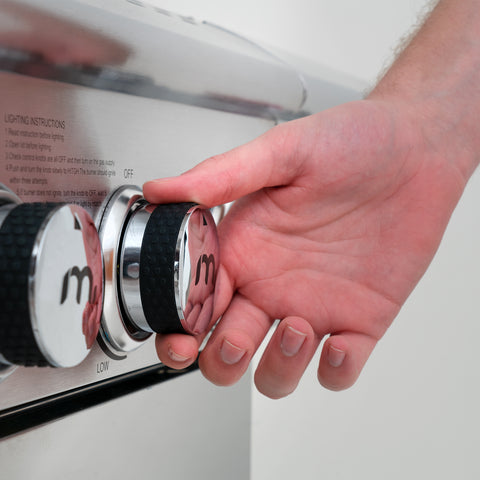
2. Turn the propane tank gas valve clockwise to the OFF position.
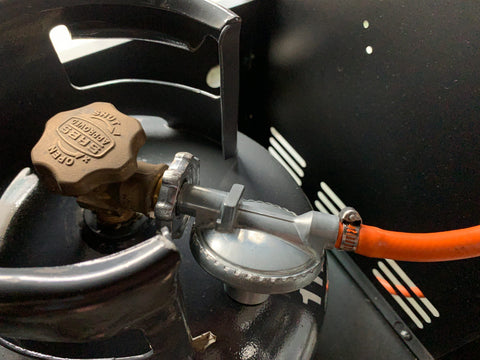
3. Remove the gas grill regulator coupling nut from the propane tank by turning the coupling nut counter-clockwise.

4. Remove the propane tank from the grill.

5. Locate the opposite end of the gas grill regulator gas hose, where the brass fitting connects to the manifold.
6. Using an adjustable wrench, disconnect the brass fitting by turning it counter-clockwise. Secure the manifold using another wrench while disconnecting the brass fitting.
7. Dispose of the faulty gas grill regulator and gas hose.
8. Attach the gas grill regulator replacement gas hose by turning the brass fitting clockwise onto the manifold until it is hand-tight.

9. Using the two wrenches, tighten the brass fitting onto the manifold. Do not over-tighten the connection.
10. Place the propane tank into the opening in the propane tank compartment and re-attach the gas grill regulator coupling nut to the propane tank by turning it clockwise.
11. Perform the Soapy Leak Test to ascertain a fully sealed, leak-free propane gas tank and regulator.
12. Once you’ve confirmed there are no gas leaks, ignite the burners following the instructions in your grill’s Owner’s Manual.
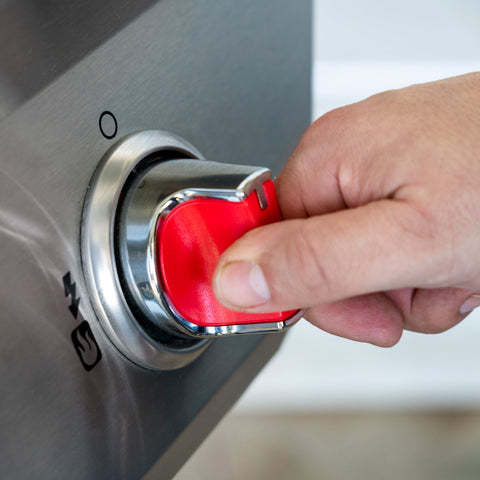
It’s essential to purchase a suitable gas grill regulator replacement. Did you know you can order all your replacement gas grill parts from mygrillparts.com?
Finding the Right Gas Grill Replacement Parts
My Grill Parts is the go-to supplier for quality gas grill replacement parts.
We’ll make sure that you can grill safely and conveniently year-round. Using our website, you can search for your replacement grill parts by brand. You can also find what you need by entering your grill’s model number.
If you don’t see the grill replacement part you’re looking for on mygrillparts.com, please feel free to contact us.
We’re more than happy to assist – and get you back to grilling in no time!
